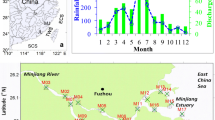Abstract.
Variability in chromophoric dissolved organic carbon (CDOM) was characterized in and around the Cape Fear River and Onslow Bay, North Carolina USA. The river end member of the study is extremely rich in CDOM, thus the Cape Fear River serves as a point source of CDOM-rich water into the southeastern Atlantic bight. The river plume is easily traceable and generally extends in a southwesterly direction along the coastline into Long Bay. Depending on physical processes and river flow, the plume can meander somewhat and may even turn northward for short periods of time. The oceanic end member of this study was the Gulf Stream. Samples from the Gulf Stream were obtained up to 97 km off shore. The experimental approach focused on the qualitative and quantitative description of CDOM from fresh-to-oceanic waters. CDOM was characterized by excitation emission matrix (EEM) fluorescence and UV/VIS spectroscopy. Variability of CDOM absorption in the relatively small area of the Cape Fear River estuary and surrounding coastal ocean was very high. The observed range of variability of CDOM absorption coefficient, a CDOM (350), extended over nearly the entire range of CDOM absorption in the literature: 0.046 = a CDOM (350) = 29.9 m–1. Changes in CDOM absorption spectrum slope coefficient S, were small in the Cape Fear River plume area, but relatively large in Onslow Bay. CDOM EEM spectra indicated that a radical change in composition of CDOM occurs along the river-to-oceanic salinity gradient. CDOM in the coastal ocean was characterized by strong reduction of the three principal intensity peaks: A, C, and M, and a prominent contribution of the T peak to the fluorescence spectrum. The fluorescence intensity is linearly related with absorption. There is a strong inverse relationship between salinity and CDOM absorption. The distribution of the slope coefficient and the percent contribution of respective peak intensities to the total EEM intensity showed that CDOM undergoes conservative mixing until it approached oceanic salinity. Thus, CDOM is so concentrated in the river that mixing and other physical processes mask photochemical or biological alteration of its composition.
Similar content being viewed by others
Author information
Authors and Affiliations
Corresponding author
Additional information
Received: 10 May 2003; revised manuscript accepted: 16 August 2003
Rights and permissions
About this article
Cite this article
Kowalczuk, P., Cooper, W.J., Whitehead, R.F. et al. Characterization of CDOM in an organic-rich river and surrounding coastal ocean in the South Atlantic Bight. Aquat. Sci. 65, 384–401 (2003). https://doi.org/10.1007/s00027-003-0678-1
Issue Date:
DOI: https://doi.org/10.1007/s00027-003-0678-1




